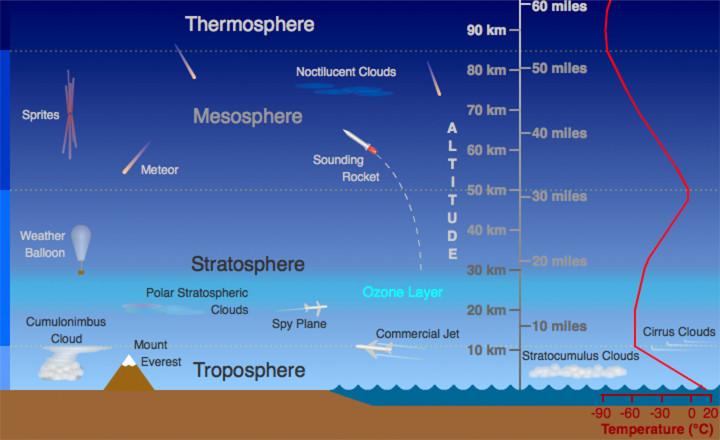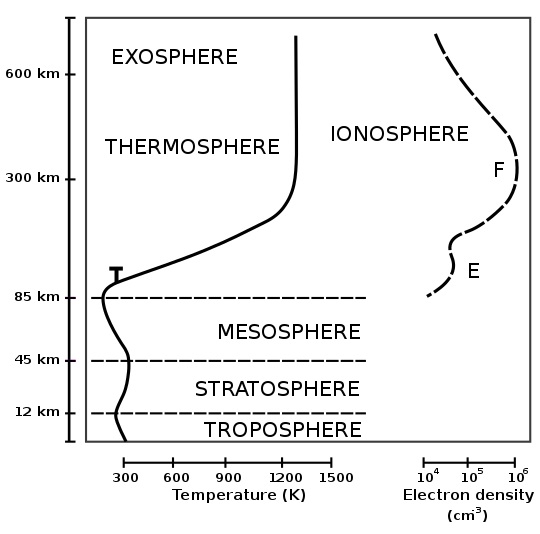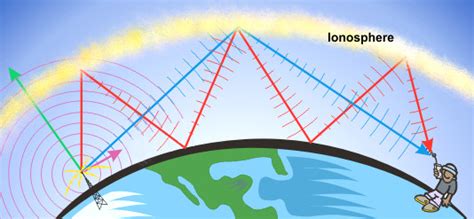 Many thanks to SWLing Post contributor, Jock Elliott, who shares the following guest post:
Many thanks to SWLing Post contributor, Jock Elliott, who shares the following guest post:
You and the ionosphere . . . a reader participation post
By Jock Elliott, KB2GOM
Here’s a shocker for you: we live at the bottom of the sky. Above us there are multiple layers of the atmosphere, pressing down on us at 14.7 pounds per square inch.
Of particular relevance to us as shortwave listeners and hams, there is a special layer of the atmosphere, not shown on the chart above called the ionosphere. The ionosphere starts around 30 miles above us and extends up to about 600 miles and includes parts of the layers above.
The Sun’s upper atmosphere, the corona, is very hot and produces a constant stream of Ultra-Violet and X-rays, some of which reach our atmosphere. When the high energy UV and X-rays strike the atmosphere, electrons are knocked loose from their parent atoms and molecules, creating a layer of electrons.
Now, here’s the cool part: this layer – the ionosphere – is important because radio waves bounce off of it.
The sun, however, is not constant in its action on the ionosphere. The amount of UV and x-ray energy (photon flux) produced by the sun varies at by nearly a factor of ten as the sun goes through an 11 year cycle. The density of the ionosphere changes accordingly, and so does the ability of the ionosphere to bounce radio waves. When the sun is at peak activity, and the ionosphere is “hot,” SWLs and hams are likely to experience excellent long-range propagation. When the sun is quieter, long-range propagation diminishes.
Every 11-year solar cycle is unique, but early indications are that we may on the verge a cycle that favors long-range propagation: https://swling.com/blog/2022/03/termination-event-may-indicate-solar-cycle-strength/
The results can be spectacular. Decades ago, during a particularly hot solar cycle, I once spoke from my station near Albany, NY, to a station in the state of Georgia on a mere 4 watts. On another occasion, I conversed with a ham in Christchurch, New Zealand – a distance of over 9,000 miles – with 100 watts single sideband transmit power. During that same period, I would routinely listen to shortwave stations halfway around the world.
And now, it’s your turn – what’s your favorite long-range propagation story, either as an SWL or ham? Please comment!




not ham but my farest DX catches at corfu greece
MW 1560 khz family radio wfme indoor with small portable radios internal ferrite antennas (note they are only transmitting max 50KW so it is a good catch)
https://youtu.be/BGWHeWWTp7A
SW6507 khz vmc australian marine weather with 3m wire again indoors just over 15000km tropo, signal indeed did all circle at ionosphere, for my location is the other end of the world (at time near by was storm) my guess they are not using some huge KW
https://youtu.be/V2VPNt83410
thank you
Babis,
There is not much to say, except: Wow!
Cheers, Jock
I once worked a 2 meter station on the USS North Carolina museum ship in Wilmington NC from the southside of Jacksonville, FL. That was about 350 miles and is the longest 2 meter contact I have ever made. It was a special event station and it happened back about 2010. You don’t get many of those types of opportunities in our hobby and some people never get the opportunity. But when you do, they are magical.
W4MKH
https://w4mkh-qrp.com/
Marshall,
Sweet!
Cheers, Jock
My oddest was long delay echoes. 2013, 80 metres, CW, 100 W from Bermuda (VP9). Trying to work other amateurs in a pile-up, but hearing myself come back as an echo about THREE seconds later while using full break-in (QSK). Nobody knows what causes this. Some operators never hear this in all their years on the air. I’ve also heard this on 15 m, but it was some time in the 1990s. Very odd as it takes onnly 1/7 of a second to go once around the world. What can cause such a long delay? No, it wasn’t somebody fooling around either! This lasted for about 5 minutes. Oh, it was about 23:00z in November.
Wow. I wonder if you got lucky with some moon bounce.
I think there might be a connection between geomagnetic storms and Transatlantic MW DX. Either two or three times, AFTER we had geomagnetic storms (probably K5-K8), for 1-2 hours there were massive boost (like 10-20 db) to European MW stations into my Philadelphia listening post and it was the best European MW DX I’ve ever seen with my equipment and location. This was several years ago back when there were more stations in France, Germany and other countries.
This is especially weird, because my path to Europe would be a northern one that would be attenuated by these storms. So normally I get enhancement to the south – notably Cuba, Colombia, and Venezuela.
To reiterate – the enhancement happened after the storm had died down.
As of yet, I haven’t seen anyone else mention a similar phenomena.
Last summer, while sitting on the swing in the back yard, I made a contact with a ham in Moscow using my KX2 at 5watts and the AX1 antenna. The AX1 was clamped to the top bar of the swing just above my head. I’ve had many memorable contact’s but this one amazed me because the conditions weren’t good and I was using the AX1. I wasn’t sure this had actually happened until I received an eqsl from the Russian ham. ?
Robin. NG8S
So I had been trying to catch the Radio St. Helena yearly broadcast for going on a decade. One year, I had finally strung up a nice stealthy longwise on the roof of my Federal Way, WA house… it was only 2″ above the peak of the roof and as tight as a guitar string.
It was fed into a 9:1 balun into my Grundig Satellit 800.
Shocker: I heard them. I mailed off a reception report in 2007 and nearly a year later I got my QSL card.
Mission Accomplished!
A fellow Satellit 800 user . . . well done!
Cheers, Jock
Thomas
Though not a ham, but a SWL and CB’r, back around the late 1970″s I was talking to a fellow CB operator from my home in Dillsburg PA. During a lull in the action, another CB’r broke for us and we learned that he was in Zephyr Hills Florida. He couldn’t believe we were in Pennsylvania. The conversation lasted about 5 minutes, then the air got noisy again and he was gone. Pretty good “jump” for a 4 watt base station.
Enjoyed the other posts concerning skip
My experience isn’t SW or HAM related. Back in about 2001 or so I was setting up an old 12 B&W TV for one of the kids and had it tuned to channel 2 WBBM in Chicago, this was obviously before analog went away. On the rabbit ears alone the Chicago station went black between segments and I saw just a ghost image of the Channel 2 KXAS out of DALLAS,TX!! The conditions were just right at the time and I was there to catch it!
Great catch!
Cheers, Jock
Jim,
Your reception was not reflected from the ionosphere but was tropospheric ducting. This occurs when there is cold air near the ground and warmer air above. The change in air density causes a “tunnel” where the signals bounce from side to side. It is most common around large water bodies.
“Sporadic E” (ionospheric) skip is a well-known and well-documented phenomenon also on VHF, occasionally extending beyond 200MHz.
Jim did not say at what time of day this reception happened.
Ionospheric propagation characteristics including Sporadic E https://www.sws.bom.gov.au/Educational/5/2/2
Tropospheric modes
https://www.dxinfocentre.com/propagation/tr-modes.htm
The America’s channel 2 is 54 – 60 MHz. Like all VHF and UHF channels subject to tropospheric ducting.
This channel along with channels 3 – 6 are now virtually deserted. An ideal opportunity to use it for Digital Radio Mondiale for similar coverage. A single DRM channel in this band is half the bandwidth of an FM channel and a quarter of an HD radio channel yet will carry 3 good quality stereo radio programs.
This is 300 DRM transmission channels for those vacant channels, more than AM and FM combined.
My first thought is the breathtaking propagation I witnessed on May 7, 2018 as part of the annual W9IMS (Indianapolis Motor Speedway) special event. We had stations going on 20 and 40 meters at the time, and I was chatting on the landline with our club president, who casually mentioned that we’d been spotted in Australia a few minutes earlier on DX Summit.
Sure enough, when I checked the spots, there was one from VK6APZ at 2301 UTC, stating that W9IMS had been “hrd in vk6 long path”. That corresponded to 7:01 p.m. Indy time, and there was no path of darkness.. The sun still shining in the Hoosier State, with sunset still 90 minutes away. Not bad for 20 meters, I thought.
Except … it wasn’t a spot for 20 meters. It was a spot for 40 meters! I blinked twice just to make sure I was reading it right.
Yes, it definitely said 40 meters. But I wanted more than a DX spot — I wanted a QSO! Or had the rare opportunity gone by the wayside?
I quickly messaged our on-air W9IMS op and told him to call the Aussie immediately. To my amazement, I soon heard the voice of a delighted (and grateful) VK operator emerging from my speaker.
I’ve been a ham since 1971 and an SWL for a couple of years longer. But aside from that day, I’ve never heard Australia on 40 meters in the Indiana sunshine.
Impressive!
Cheers, Jock
The shortest path requires the Indianapolis antenna needs to be pointed at a surprising 287 degrees and and a path length of 17800 km assuming that VK6APZ is in Perth West Australia which is where most of the state’s population lives.
The reason why the bearing is North of West is because the earth is a sphere. The usual Mercator’s projection stretches more and more as you move away from the equator towards the poles.
On the peak of the glorious cycle 23 (1996-2008) around 2000, I had a puny coaxial folded dipole antenna a.k.a. “double-bazooka” for CB strung up under the ceiling of my 4th floor apartment. I could barely reach everyone across the city with it but due to the extraordinary conditions at that time, I had SSB and FM (!) contacts across the big pond (from Germany) on an almost daily basis (a few times even at night!) with that thing, to Thailand in PSK31 and so on. Most of these contacts were made with a ‘President Lincoln’ (known as ‘Uniden HR-2510’ in the US) and 12W PEP output. The icing on that cake was an SSB QSO with South Africa though, made with a ‘Dragon SS-201′ handheld with SSB (6W PEP in SSB) hooked up to that dipole (I still have the QSL card!).
That was also the time I witnessed the 100W signal of my buddy Jürgen circumnavigating the globe on 27MHz, something I considered “yarn” until then. His mic made a characteristic noise when releasing the PTT and while he made a contact (with IIRC Australia) I noticed that this noise was repeating itself. After ruling out that this is some jokester I asked him to press the PTT a few times in short intervals so I could record the signal and measure the time between the direct and the echoed signal and sure enough it was some 120ms in between. Later I learned that “long echoes” are not unknown among hams, and even much longer echoes have been recorded but on 11m, with such a still moderate power on an omnidirectional vertical antenna I still think this is quite extraordinary.
Aforementioned “Lincoln” still exists, and when I moved to the coast and got a car in 2013 I was curious to see if it still works, so I bought a less than 3’ short “Little Wil” magmount antenna, drove to a nearby parking lot and hooked it all up – the only thing I could hear was some US stations and so I made a call, which was promptly answered by a station in North Carolina (no, not Thomas). IOW, even when a sunspot cycle is as underwhelming and short as cycle 24 it’s still fun, and some great SWLing results in the following years proved that the ionosphere can still provide a lot of opportunities and fun even when a minimum bottoms out at record activity lows.
” even when a sunspot cycle is as underwhelming and short as cycle 24 it’s still fun, ”
Exactly!
Cheers, Jock
One of my most memorable contacts was with the Amundsen Scott South Pole Station in Antarctica back in April 2014 at 1:50 in the morning Eastern standard Time. As I recall they were in their near total darkness time of year, and of course it had been dark for some time at my location in Southern Ohio. The fella came in bright and clear on single side band, and I worked him after the first or second call. As you can imagine soon a pile up began, so it was especially cool to be one of the first to work him.
As this was the southern-most tip of the world, it was even more special. 20 meters should not have been open at that time of night, and especially since there was no Gray line propagation, I’ve always been amazed we were able to work. Cheers! Robert K4PKM
Wow, memorable contact! Very cool.
Cheers, Jock
You just reminded me of another memorable long-range propagation experience. I was operating 20-meter CW in 1988, before the fall of the Berlin Wall, when I copied an East German station calling CQ after midnight. “Strange time to be hearing East Germany,” I thought as I replied from my Indianapolis apartment.
Back then, East German stations typically used calls starting with a Y and followed by 2 numbers, such as Y26 and Y54, and 2 letters. But this call had the higher-than-usual number of 88, along with a 3-letter suffix — Y88POL.
Oh well, I figured, WFWL (work first, worry later). The East German op came right back to me with a signal report and his first name. Then he gave his location: “A N T A …”
I was operating in a fairly dark room, unable to see exactly what I was writing, so it still hadn’t dawned on me. Then came the rest of his QTH : “R C T I CA.” I held my notepad under the glow of my radio.
Wait a minute … WHAT??? I gasped when I finally got a chance to read what I’d jotted down: “ANTARCTICA.” That certainly explained the unusual time for an East German station and the “POL” in the suffix.
Needless to say, I treasured the QSL card, which presented a desolate-looking image of an Antarctic research station identified as Georg Forster. (Here’s an online copy: https://web.hamradio.hr/9a6aa/Antarctica/y88pol.htm )
To this day I still feel a surge of adrenaline when I look at it.
Neat story, Thomas!
If I recall correctly, Gary DeBock worked 144 countries with a 1-2 watt transmitter he built himself. Gotta have some serious propagation (and knowledge and skill) to get that done.
Let’s all conspire together to encourage Cycle 25: “C’mon Cycle 25, you’re the Cycle that could!”
Cheers, Jock
My story.
Back in August of 2008 I had a QSO from my home in Florida with Gia (4L4WW) in Georgia on 14.270. That was a distance of approximately 6,400 miles. The next morning I woke up to the news that Russia had attacked Georgia overnight . I’m not up on the politics of the situation but that isn’t the point. The real point is that ham radio has a way of making worked events more personal.
I blogged about this back then and a few days later Gia posted a comment on my blog post stating that he was okay.
Thanks, Marshall, excellent story!
Cheers, Jock
I love this, Jock! The past few years, it seems we can only complain about the lack-luster performance of our local star. Your post reminds us to think back and remember some positive propagation! I do sincerely believe Cycle 25 might be a good one, so it’s nice to focus on the positive that awaits.
On the ham radio side of things, I’ve also had some pretty amazing propagation openings in the past.
In particular, I remember driving to work in the 1990s and listening to my RadioShack HTX-10 ten meter transceiver. I heard a ham in Glasgow, Scotland speaking with another ham in California (I can’t recall the town). I was in Hickory, North Carolina (obviously) mobile and maybe 10 watts.
I couldn’t help it–I politely asked to break into their conversation long enough to see if they could both hear my puny signal emanating from a 10M mag mount antenna. Indeed they did! We all got a good chuckle about this superb 10 meter opening. The thing that really struck me, too, was that we were all 5 by 9–armchair listening as I was driving down the road.
I do hope Cycle 25 can provide some opportunities like this! I choose to believe it will!
Cheers,
Thomas